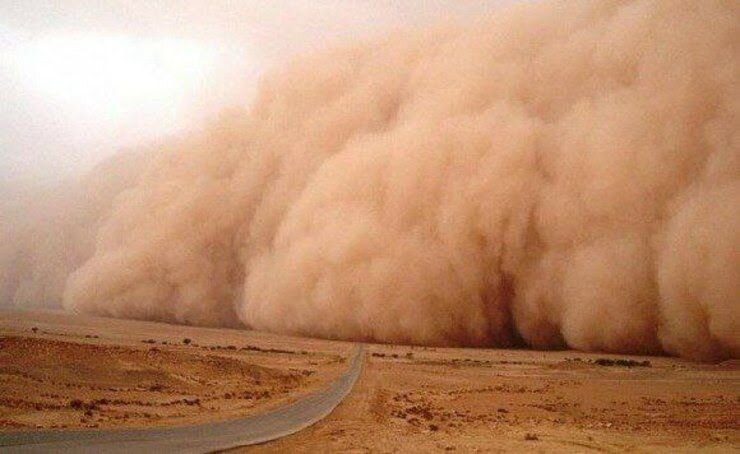Iran prioritizes co-op with Iraq to mitigate SDSs

TEHRAN –As sand and dust storms (SDSs) hotspots in Iraq severely affect western and southwestern regions, the administration underscores cooperating with Baghdad to address the problem.
On September 15, Foreign Minister Abbas Araqchi in a meeting with the head of the Department of Environment (DOE), Shina Ansari, highlighted that one of the main axes of cooperation with Iraq will focus on conducting joint environmental activities as well as following up on previous agreements made in this regard, IRNA reported.
A report published by four Iranian researchers suggests that the main sources of sand and dust storms affecting Iran are emerging from Iraq, Syria, and Saudi Arabia.
Titled ‘Dust in Western Iran: the emergence of new sources in response to shrinking water bodies’, the report written by Azar Beyranvand, Ghasem Azizi, Omid Alizadeh, and Ali Darvishi Boloorani was published by Nature on September 27, 2023.
“The most influential sources affecting Western Iran are located on the shore and northwest of Lake Tharthar, Hour-al-Azim Marsh, the shore of Razzaza, Habbaniyah Lakes, and West Hammar Marsh, which contributed to 110, 79, 59, 56, and 51 dusty days, respectively.”
Indeed, the peak dust activity in Western Iran was during the period 2008–2012 in response to the substantial shrinkage of the main water bodies in Iraq.
The main sources of dust influencing Western Iran are located in northern and eastern Saudi Arabia in spring, Deir ez-Zur in Syria’s Aleppo and Raqqa in summer, and Syria’s Homs and Al-Hasakah in winter and spring.
Western Iran here refers to the western half of Iran, which encompasses northwest, west, and southwest Iran. To identify dust events in western Iran during the period 2000–2016, meteorological data from 33 synoptic stations were obtained from the Meteorological Organization of Iran.
About 1133.5 km2 of regions in West Asia with permanent surface water in 1984 completely dried up in 2015 and acted as potential sources of dust.
Decreased precipitation in West Asia from autumn 2007 to 2012 and the occurrence of severe droughts have also contributed to the shrinkage of lakes and wetlands, as well as the reduced agricultural productivity in West Asia, all of which contributed to the intensification of dust activity in Western Iran in recent decades.
According to the results, the main sources of dust that influence Western Iran are located in Iraq. Decreases in the surface water of lakes in Iraq have led to the emergence of some new sources of dust, which contributed to a substantial increase in dust activity in western Iran in recent years.
Measures taken
Sand and dust storm, in general, is a global crisis and most of the dust storm hotspots affecting the country are located in neighboring countries, ISNA quoted Ali-Mohammad Tahmasbi-Birgani, an official with the DOE as saying.
Holding the international conference on dealing with sand and dust storms in September last year with the presence of representatives of more than 50 countries and international agencies was our most important measure that was taken in line with the policy of environmental diplomacy, he explained.
The measure became more important when the Tehran conference’s resolution was approved by the United Nations and became a global requirement for action against sand and dust storms, the official stressed.
“Special regulations for the management of sand and dust storms in emergency conditions as well as environmental considerations for the development and exploitation of mines have also been prepared.”
More than 2.7 trillion rials (about $5 million) was allocated last year to projects for combating sand and dust storms, he concluded.
The 6th United Nations Environment Assembly (UNEA-6) which was held from February 26 to March 1 approved a resolution adopted at the international summit on dealing with sand and dust storms which was held in Tehran in September 2023.
The UNEA-6 was held at the United Nations Environment Program (UNEP) headquarters in Nairobi, Kenya. It is the world’s highest decision-making body on the environment.
A total of 180 countries attended the UNEA-6 meeting with a focus on how multilateralism can help tackle the triple planetary crisis of climate change, nature and biodiversity loss, and pollution and waste, IRNA reported.
The Tehran conference was a turning point in making serious decisions for implementing sub-regional programs in West Asia and Central Asia.
Climate change with all its dimensions and consequences has caused serious challenges to life on the earth. One of the consequences of climate change, which has increased in intensity and occurrence, is the phenomenon of SDSs with severe harm to the world's biological and economic resources.
According to surveys, 150 countries are affected by SDSs, and most of these countries are located in Africa and Asia.
Two out of the seven main sources of dust production in the world are located in Asia, with the Great African Sahara being the first one.
The studies by the Islamic Republic of Iran show that the dust centers in West and Central Asia are more than 3.3 million square kilometers.
MT/MG
